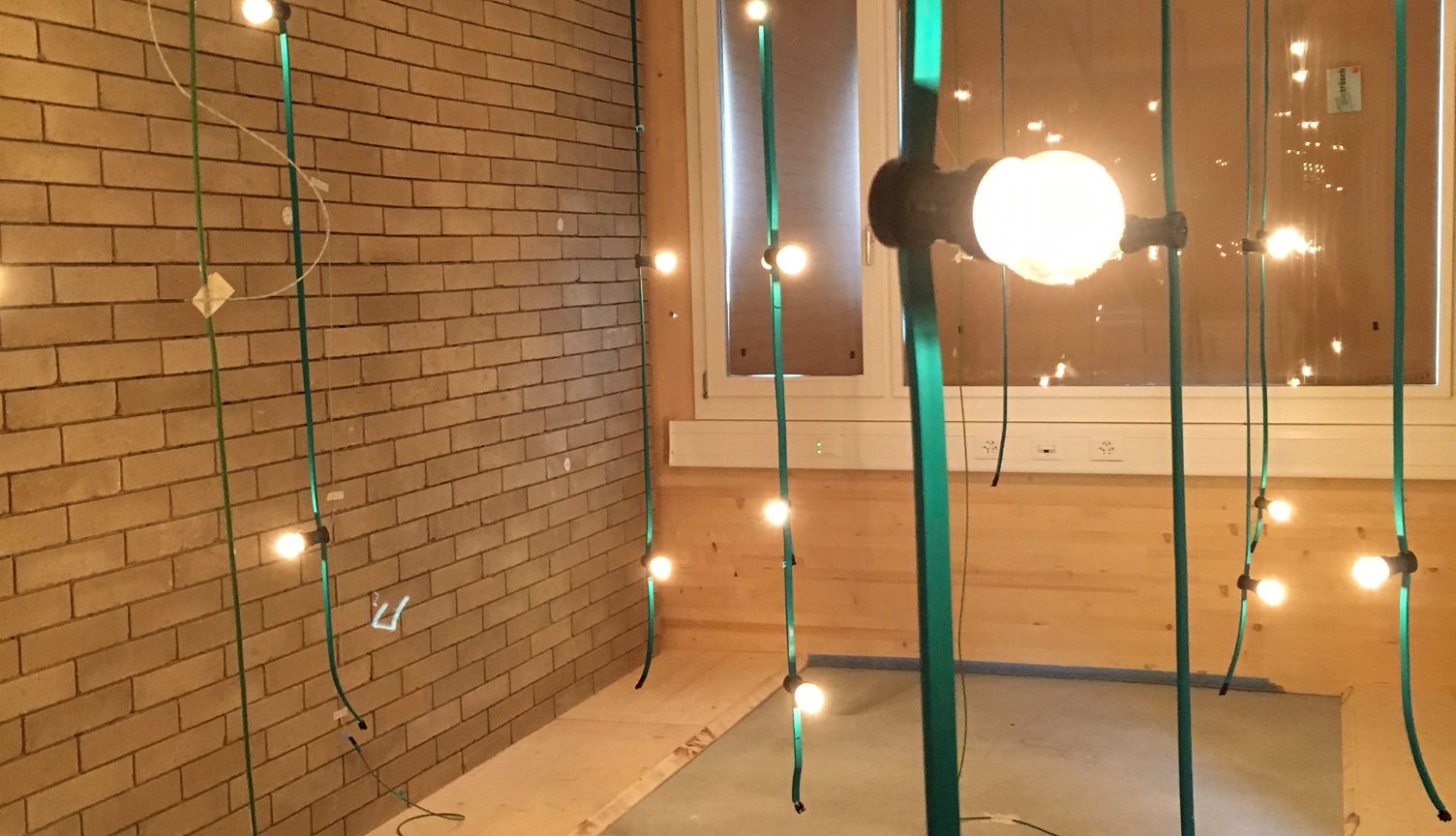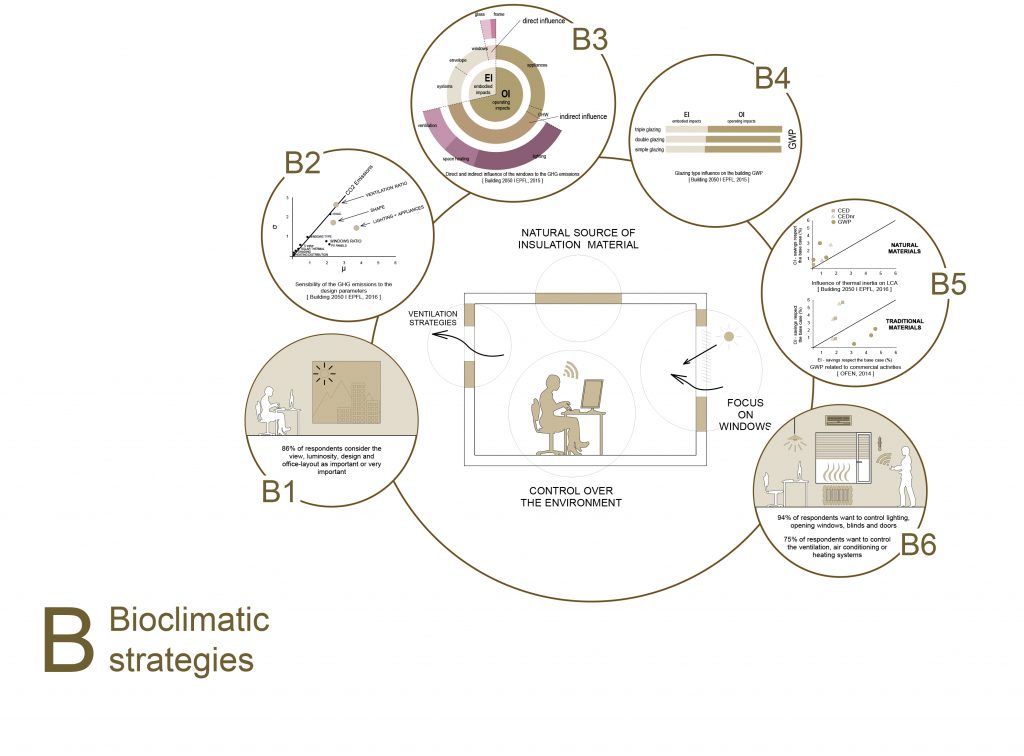Bioclimatic Strategies

The envelope, especially the glazing part and the side-effects induced on ventilation and lighting are of major influence on the building’s environmental impacts and user comfort (04-B3). To reduce the impacts of the façade itself, it is important to work on the materials involved in the construction. On the other side, to minimize the impacts related to the building’s consumption, it is important to improve ventilation and daylighting, which have clear influences on the façade’s design (04-B2).
Building Automation Systems (BAS) have been widely studied and have demonstrated a significant energy-saving potential in many situations. Nevertheless, advances in BAS technologies have typically been focused on primarily optimizing the trade-off between energy use and objective comfort and overlooked the importance of the occupants’ interactive experience with their environment.
Adopted approach for the SLB research program on bioclimatic strategies
A prototyped office space consisting of two rooms was designed and built. Comfort assessment and acceptability of the design solutions were investigated by a user survey. Participants answered a questionnaire about their comfort perception according to the operated ventilation, windows and shading (manually or automatically) in these rooms.
In order to improve the operating consumption by storing internal or external heat gains, thermal inertia is widely used as a bioclimatic strategy. Previous studies highlighted the difference between the thermal behaviour
results obtained with tests on earth materials, like experiments in controlled climatic
chambers and real-world applications. In the literature, the potential of earth
as a bioclimatic lever has not yet been investigated in real conditions.
An application of Compressed Earth Bricks (CEB) has been used as a case study to analyse
the thermal behaviour of an earthen wall and the potential of coupling it with night ventilation to stabilize temperatures and increase indoor comfort. Results obtained in two different rooms, representative of lightweight and heavyweight earthen construction, have been compared.
For further details, see publications below
Partners
CRAterre, ENSAG, Grenoble (France)
Estia, EPFL Innovation Park
LIPID, EPFL
Funding
State of Fribourg – Switzerland
Please note that the publication lists from Infoscience integrated into the EPFL website, lab or people pages are frozen following the launch of the new version of platform. The owners of these pages are invited to recreate their publication list from Infoscience. For any assistance, please consult the Infoscience help or contact support.
Low-carbon thermal inertia
Exploring. Research-driven Building Design. Towards 2050; Zürich: Park Books, 2019. p. 276.Research at the service of building design
Exploring / Research-driven Building Design. Towards 2050; Zürich: Park Books, 2019. p. 276.On the Influence of Thermal Mass and Natural Ventilation on Overheating Risk in Offices
Buildings. 2018-03-22. Vol. 8, num. 4, p. 47. DOI : 10.3390/buildings8040047.Life cycle efficiency ratio: a new performance indicator for a life cycle driven approach to evaluate the potential of ventilative cooling and thermal inertia
Energy and Buildings. 2018. Vol. 163, p. 22-33. DOI : 10.1016/j.enbuild.2017.12.010.Preventing overheating in offices through thermal inertial properties of compressed earth bricks: A study on a real scale prototype
Energy and Buildings. 2017-12-01. Vol. 156, num. 1 December 2017, p. 281-292. DOI : 10.1016/j.enbuild.2017.09.070.“Our Inherent Desire for Control”: a Case Study of Automation’s Impact on the Perception of Comfort
Energy Procedia. 2017. num. 122, p. 925-930. DOI : 10.1016/j.egypro.2017.07.414.Smart Living Building Research Program – Executive Summary
2017
Building 2050 – Scientific concept and transition to the experimental phase
2016
Graphical representation of the smart living building research program
Building2050 Scientific Workshop, Gruyères, Switzerland, October 2016.smart living building – Living the Future
2016
LCA as key factor for implementation of inertia in a low carbon performance driven design: the case of the smart living building in Fribourg, Switzerland
2016. Sustainable Built Environment (SBE) Conference, Zurich, Switzerland, June 15-17, 2016.Impact targets as guidelines towards low carbon buildings: Preliminary concept
2016. PLEA, Los Angeles, USA, July 11-13, 2016.Towards a pre-design method for low carbon architectural strategies
2016. PLEA2016, Los Angeles, USA, July 11-13, 2016.Building 2050 – State-of-the-arts and preliminary guidelines
2015
